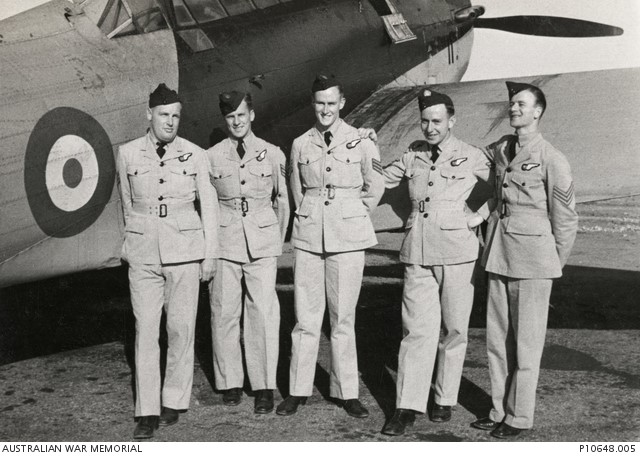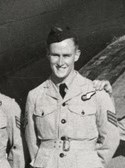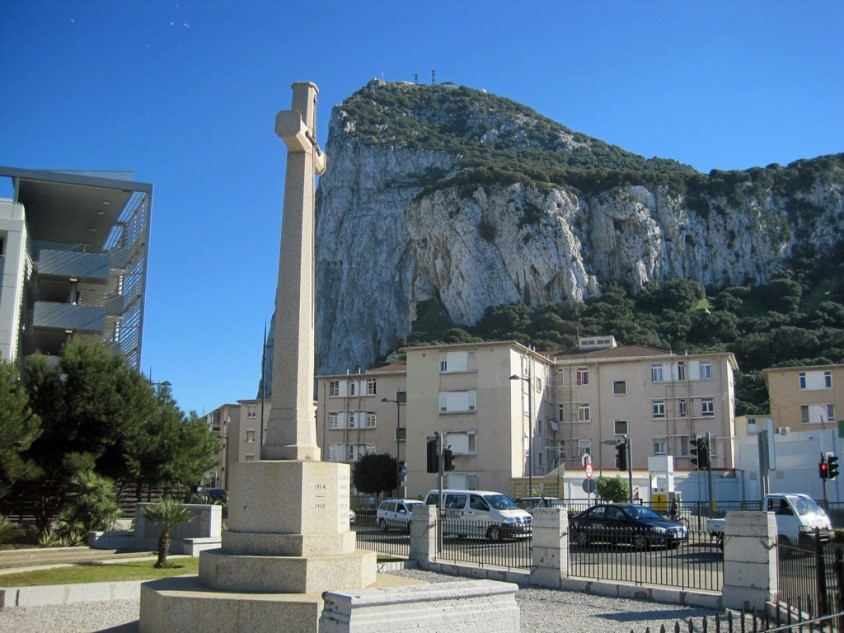Sergeant William Samuel Charles Atherton, the son of Reverend Samuel Atherton and Frances Marian Atherton (nee Millar), was born at Toowoomba in Queensland on 20th September 1919. He was educated at the Drayton State School and the Church of England Boys’ Preparatory School before attending the Toowoomba Grammar School during the years 1934-1935 where he completed the Junior Public Examination. He applied for aircrew training in the Royal Australian Air Force on 30th January 1940. He had previously served for five months in the Citizen Military Forces in the Signals Corps. He had previously applied for Wireless Operator training in the R.A.A.F. on 16th January 1940. At the time of his application he was employed as a Bank Clerk with the Commonwealth Bank, Queen Street, Brisbane and resided with his parents at The Rectory, 67 High Street, Toowong, Brisbane.
Sergeant William Atherton was enrolled in the Reserve of the R.A.A.F. on 8th April 1940 after swearing an oath of allegiance. At the age of 20 years and 10 months he was enlisted into the Citizen Air Force of the R.A.A.F. at No. 3 Recruiting Centre in Brisbane on 12th April 1940 after giving a commitment that he would serve for the duration of the war and an additional twelve months. His physical description at the time of enlistment was that he was 6 feet tall and weighed 128 pounds. He had a fair complexion, hazel eyes and fair hair. He stated that he was of the Church of England religion. He gave his next of kin as his mother, Mrs Frances Marian Atherton, 67 High Street, Toowong, Brisbane.
Sergeant William Atherton was allotted the service number of 404322. He joined No. 2 Initial Training School at Lindfield in New South Wales on 19th August 1940 where he was trained in the basics of service life. He joined No. 2 Elementary Flying Training School at Archerfield in Queensland on 17th October 1940. He rejoined No. 2 Initial Training School at Lindfield in New South Wales. He joined No. 2 Embarkation Depot at Bradfield Park on 12th January 1941 to prepare for movement overseas to Canada where he would continue his aircrew training. He embarked from Sydney in New South Wales on 23rd January 1941 on attachment to the Royal Canadian Air Force. After arrival in Canada he joined No. 2 Air Observer School at Edmonton in Alberta on 17th February 1941. He joined No. 2 Bombing & Gunnery School at Mossbank in Saskatchewan on 12th May 1941. After completing his training at Mossbank he qualified for the Air Observer qualification badge on 23rd June 1941. He then joined No. 1 Air Navigation School at Rivers in Manitoba on 24th June 1941. He was transferred to No. 1 Manning Depot at Halifax, Nova Scotia on 22nd July 1941 to prepare for service in England on attachment to the Royal Air Force.
Sergeant William Atherton embarked from No. 1 Manning Depot at Halifax, Nova Scotia on 13th August 1941. After arrival in England he joined No. 3 Personnel Reception & Despatch Centre at Brighton on 16th August 1941. He joined No. 28 Operational Training Unit on 23rd August 1941 and later No. 27 Operational Training Unit at Royal Air Force Station Lichfield on 25th August 1941 where he was trained for night bombing using Vickers Wellington aircraft.. He was transferred to No. 15 Operational Training Unit at Royal Air Force Station Harwell on 26th December 1941 where he continued training using Vickers Wellington aircraft. He was posted to the Middle East on 8th January 1942 where his unit carried out seven operational missions.

Australian War Memorial photograph P10648.005.
Group portrait of five RAAF graduates at an Empire Air Training Scheme Observers’ School at Mossbank, Saskatchewan, Canada. Sergeant William Charles Atherton is in the centre of the group.
Sergeant William Atherton was an Air Observer and crew member of No. 15 Operational Training Unit Royal Air Force Wellington Bomber, Z Zebra, that went missing in air operations near Gibraltar on 9th January 1942. The aircraft which was proceeding to Malta went down into the sea, just before midnight, near Europa Point, Gibraltar. The Air Ministry advised his father residing at 67 High Street, Toowong, Brisbane, that he was missing as a result of air operations and believed killed. His father was advised on 4th February 1942 that his body was recovered and subsequently buried at sea. His body was recovered by the Royal Navy vessel “H.M.S. Westcott” 20 miles east of Gibraltar but operational conditions prevented the body being brought to shore for burial and it was subsequently committed to the deep. At the time of his death Charles Atherton was 22 years of age. His name was originally recorded on the Runnymede Memorial to the missing but as his body was retrieved his name was therefore recorded on the Gibraltar Memorial. An explanation of the reason his name was to appear on the Gibraltar Memorial was advised to his mother, residing at “Shenstone”, 114 Brighton Terrace, Sandgate, in the following letter on 19th November 1953:
The reason for the deletion of your son’s name from the Runnymede Memorial was that it is essentially a memorial to the missing; to commemorate those who lost their lives on war service but whose bodies were never recovered for burial. Your son’s body was recovered and identified, and though the circumstances at the time prevented burial in a cemetery, and his body was committed to the deep in the manner traditional for those of the British race who lose their lives at sea, he was in no sense “missing”. Those who were laid to rest in war cemeteries are commemorated by headstones erected over the graves in the country in which they lost their lives. Their names are not included on the Runnymede Memorial or any of the other regional memorials established by the Imperial War Graves Commission. It is thought to be in keeping with this principle that those who were buried at sea should be commemorated on a memorial erected in the locality in which they made their sacrifice. May I again assure you of the sincere sympathy of this Department.
As a result of enquiries made by William Atherton’s father, a surviving crew member, Sergeant Harrison of the R.A.A.F., furnished the following report to the Overseas Headquarters of the R.A.A.F. in London:
Dear Sir, Your letter of the 17th inst. Is hereby acknowledged, and the following is a report on the late Sergeant W.H. Atherton, 404332:
Sergeant Atherton left Lichfield R.A.F. Station on or about October 25th 1941, as the Observer of a crew captained by Pilot Officer Powell. After some time at an operational squadron, this crew was found to be too inexperienced for the particular job in hand and was then posted back to Lichfield for a period of further flying experience. On arrival at the above R.A.F. Station, Sergeant Atherton was transferred from Pilot Officer Powell’s crew to one captained by Pilot Officer T. Maloney, R.A.A.F. of Melbourne, Victoria, and myself as rear-gunner, making a total of four Australians in a crew of six, the two remaining members, viz. Sergeant G. Hall, Wireless Operator/Air Gunner, and Sergeant A. Morris, Wireless Operator/Air Gunner and front gunner, being of the R.A.F.
Having been found satisfactory in every respect, we were then posted as an operational crew and ultimately briefed for an overseas flight. For full particulars of this flight, it would be appreciated if you would refer to Squadron Leader Tart, R.A.A.F. as, at his request, I have related the history of this flight in detail, which was duly recorded. Sergeant Atherton’s machine, Wellington Z-Zebra, 9101, crashed into the sea at a point somewhere off Europa Point, Gibraltar, approximately 15 minutes after take-off on the night of January 9th 1942 at 23.26 hours. Sergeant Atherton and the remainder of the crew, with the exception of Sergeant Morris were trapped in the front portion of the machine and killed instantly. The aircraft sank very quickly and I was fortunate enough to be able to get clear of the fuselage and reach the surface, where I was rescued by a patrol launch from 202 Squadron at Gibraltar.
From enquiries made while in hospital at Gibraltar and also after my discharge, personnel manning the rescue launch and the Medical Officer, Squadron Leader G. Harbill, R.A.F., assured me that everything possible had been done but no wreckage or other members of the crew could be found. Sergeant Atherton and I were together for the majority of the time while he was in England, and in him I found both a conscientious and brilliant navigator and a good friend, and it would be appreciated if you would convey my deepest sympathy to his parents or next of kin, and inform that Sergeant Atherton wrote his last letter home while in my company on the night of January 3rd from the R.A.F. Station at Halton. Would you be good enough to advise Canon J.S.W. Tomlin that to the best of my knowledge both Pilot Officer Powell and Sergeant Newman were, and still are on operations against the enemy somewhere in the Middle East. It would be further appreciated if a copy of this letter could be forwarded to the next of kin of the late Pilot Officers Maloney and Patterson of Melbourne, Victoria. I remain your obedient servant.
The following newspaper report appeared in the Courier Mail on Tuesday, 10th February 1942:
Sergeant Observer W.S. Anderson was killed in air operations near Gibraltar. He joined the Royal Australian Air Force in 1940, went to Canada in 1941, and was subsequently transferred to an operational squadron in England. He was reported as missing on January 9, but later advice stated that his body was recovered and subsequently buried at sea. He was 22 years of age, and the son of the Reverend S. and Mrs Atherton, St. Thomas’ Rectory, Toowong.
For his service in World War 2, William Atherton had entitlement for the Air Observer qualification badge, 1939/1945 Star, the Aircrew Europe Star, the War Medal and the Australian Service Medal 1939/1945. His name is commemorated on Panel No. 118 at the Australian War Memorial in Canberra and locally on the Toowoomba Grammar School World War 2 Honour Board.
Note
Sergeant Charles William Atherton was an Air Observer and crew member of No. 15 Operational Training Unit Royal Air Force Wellington Bomber, Z Zebra, that went missing in air operations near Gibraltar on 9th January 1942. The aircraft which was proceeding to Malta went down into the sea, just before midnight, near Europa Point, Gibraltar.The Air Ministry advised his father residing at 67 High Street, Toowong, Brisbane, that he was missing believed killed. His body was recovered and subsequently buried at sea. His name is therefore commemorated on the Gibraltar Memorial to the missing.
Toowoomba Grammar School archive records show that he enrolled as a day student on 30th January 1934 and that he left the School on 6th December 1935 after completing the Junior examination in which he passed seven subjects. His parent was shown as Mr Samuel Anderson, Minister of Religion, Drayton. After leaving school he was employed at the Commonwealth Bank until entering the Royal Australian Air Force. Documents
The following obituary was published in the School Magazine in June 1942: The Reverend S. and Mrs Atherton, of St Thomas’ Rectory, Toowong, who were advised by the Air Board that their son, Sergeant Observer William Samuel Charles Atherton, had been reported missing on January 9th, later received advice that he “lost his life as a result of air operations near Gibraltar. His body was recovered and subsequently buried at sea.” Sergeant Observer Atherton was 22. He was educated at the Toowoomba Preparatory School and at the School. He joined the staff of the Commonwealth Bank in February, 1936. He enrolled his name and received his papers for the Royal Australian Air Force on September 6th, 1939 – three days after the outbreak of war – and between that time and his call up for service in August, 1940, he served several months with the militia in a corps of signallers. In January 1941, he went to Canada. After further training he went on to England. He was one of a number chosen in August last to navigate bombers across the Atlantic, and in November was appointed to an operational squadron.




